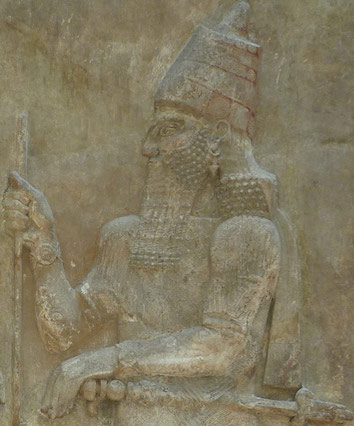Sargon II (r. 721–705 BC)

Detail of a stone relief from Façade L of the courtyard in the state apartments at the palace of Dūr-Šarrukīn (modern Khorsabad), showing Sargon II in the typical regalia of the Assyrian king, including the distinctive hat. Louvre AO 19873. Photo credit: Karen Radner.
After defeating Marduk-apla-iddina II (Merodach-Baladan) — a leader of the Chaldean tribe Bīt-Yakīn who had declared himself king of Babylon — in 710 BC, the Assyrian king Sargon II sponsored building activities at Babylon and Uruk. This was part of his responsibilities after he had taken the hand of the god Marduk during the New Year's festival and had officially become king of Babylon. Between 709 BC and 706 BC, Sargon II undertook the following building projects in Babylonia:
- Babylon
- Imgur-Enlil and Nēmetti-Enlil (the inner city walls)
- Uruk
- Eanna (temple of the goddess Ištar)
According to this king's annals from Dūr-Šarrukīn (modern Khorsabad), Sargon had his workmen dig a new canal from Borsippa to Babylon for the New Year's procession of the god Nabû.
Sargon might have also carried out work at Kish, as evident from inscribed bricks of his discovered there in 1912, and at Mê-Turān (modern Tell Haddad), as suggested by a fragmentarily preserved clay cylinder discovered not too far from Ešahula, the temple of the god Nergal. It is possible that Sargon might have had the provincial governor of Arrapha (Nabû-bēlu-ka''in) rebuild the wall of Sirara, the religious district of Mê-Turān.
In addition, Sargon gave special attention to Ehulhul (temple of the god Sîn) at Harran — a large garrison and important trading center situated on the route between the Mediterranean Sea and the plains of the middle Tigris — since that city's citizens aided Sargon in his bid for the throne against his older brother Shalmaneser V (r. 726–722 BC).
Jamie Novotny & Niclas Dannehl
Jamie Novotny & Niclas Dannehl, 'Sargon II (r. 721–705 BC)', Babylonian Temples and Monumental Architecture online (BTMAo), The BTMAo Project, a sub-project of MOCCI, [http://oracc.org/btmao/StructuresbyBuilder/Neo-AssyrianPeriod/SargonII/]